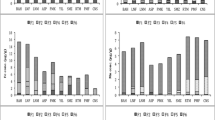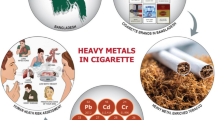Abstract
Consumed substances, including food, drink, and tobacco, produced in the environment are exposure sources of Cd. The object of the present study was to estimate Cd exposure and absorption amount from smoking cigarettes, one exposure source of Cd, using recent findings from Japan. The market share of cigarettes produced in foreign countries has increased in Japan, the proportion of tobacco leaves harvested in foreign countries has increased in cigarettes produced in Japan, and the percentage of smokers in Japan has changed. Therefore, obtaining the absorption value of Cd from smoking cigarettes using recent findings from Japan is significant.
We collected information on (1) the concentrations of Cd in tobacco leaves by country of harvest and in cigarettes by country of production, (2) the concentrations of Cd in cigarette smoke, (3) the proportion of tobacco leaves harvested in foreign countries used in cigarettes made and sold in Japan, (4) the absorption rate of Cd in the airways for cigarette smoke, (5) the smoking rate by gender, age, and year in Japan, (6) the number of cigarettes sold in Japan by year and country of production, (7) the number of cigarettes smoked by smokers per day according to gender and age in Japan, and (8) the population size in 1998 by gender and age in Japan. The mean amount of Cd absorbed via the airways by smoking for smokers in Japan was calculated to be 0.89–1.78 μg/day from the above information. The values are not small in comparison with the amount of Cd absorbed from the digestive organs.
The concentration of Cd in tobacco leaves harvested in Japan and cigarettes produced in Japan is generally higher than that of leaves harvested and cigarettes produced in foreign countries. The increase in the market share of cigarettes produced in foreign countries and sold in Japan and the increase in the proportion of tobacco leaves harvested in foreign countries used in cigarettes made and sold in Japan have decreased the amount of Cd absorbed by smoking for smokers in Japan.
Similar content being viewed by others
References
Japan Tobacco Incorporated. Outline of the JT business. http://www.jtnet.ad.jp/WWW/JT/JTI/outline/tobacco/tobaccoJ.html#menu.December 1999 (in Japanese).
Elinder CG, Kjellström T, Lind B, Linnman L, Piscator M, Sundstedt K. Cadmium exposure from smoking cigarettes: variations with time and country where purchased. Environ. Res. 1983; 32: 220–227.
Murty KSN. Lead and cadmium content of Indian flue-cured tobacco. Plant Soil 1986; 95: 281–284.
Mussalo-Rauhamaa H, Salmela SS, Leppäen A, Pyysalo H. Cigarettes as a source of some trace and heavy metals and pesticides in man. Arch. Environ. Health 1986; 41: 49–55.
Watanabe T, Kasahara M, Nakatsuka H, Ikeda M. Cadmium and lead contents of cigarettes produced in various areas of the world. Sci. Total Environ. 1987; 66: 29–37.
Saldivar L, Luna M, Reyes E, Sato R, Fortoul TI. Cadmium determination in Mexican-produced tobacco. Environ. Res. 1991; 55: 91–96.
Lin Y. Cadmium in tobacco. Biom. Environ. Sci. 1992; 5: 53–56.
Shaikh AN, Khandekar RN, Anand SJS, Mishra UC. Determination of some toxic trace elements in Indian tobacco and its smoke. J. Radioanal. Nucl. Chem. 1992; 163: 349–353.
Kalcher K, Kern W, Pietsch R. Cadmium and lead in the smoke of a filter cigarette. Sci. Total Environ. 1993; 128: 21–35.
Galas W, Kita A. Determination of ten elements in the spice samples using an inductively coupled plasma-atomic emission spectroscopy. Chem. Anal. (Warsaw) 1997; 42: 403–409.
Jung MC, Thornton I, Chon HT. Arsenic, cadmium, copper, lead and zinc concentrations in cigarettes produced in Korea and the United Kingdom. Environ. Technol. 1998; 19: 237–241.
Szadkowski D, Schultze H, Schaller KH, Lehnert G. Zur ökologischen Bedeutung des Schwermetallgehaltes von Zigaretten: Blei-Cadmium und Nickelanalysen Tabaks sowie der Gas- und Partikelphase. Arch. Hyg. Bakteriol. 1969; 153: 1–8 (in German).
Tomita K. Cadmium in Japanese cigarettes. Kankyo Hoken Report 1972; 11: 25–26 (in Japanese).
Schmidt JA, Fischbach ED, Burkart F. Cadmium studies on the effect of environment, soil and variety on tobacco can cadmium transfer into cigarette smoke. Z. Lebensm. Unters. Forsch. 1985; 180: 306–311 (in German).
Suna S, Nakajima Y, Sanenari F, Nakagawa F. Pollution of cadmium and lead by smoking. J. Shikoku Public Health 1988; 33: 149–153 (in Japanese).
Menden EE, Elia VJ, Michael LW, Petering HG. Distribution of cadmium and nickel of tobacco during cigarette smoking. Environ. Sci. Technol. 1972; 6: 830–832.
Hirano S, Suzuki K. Metabolic behavior and effects of heavy metals deposited in the lung. Eisei Kagaku 1989; 35: 241–260 (in Japanese).
Krivan V, Schneider G, Baumann H, Reus U. Multi-element characterization of tobacco smoke condensate. Fresenius J. Anal. Chem. 1994; 348: 218–225.
Smith CJ, Livingston SD, Doolittle DJ. An international literature survey of “IARC Group I carcinogens” reported in mainstream cigarette smoke. Food Chem. Toxicol. 1997; 35: 1107–1130.
Friberg L, Piscator M, Nordberg GF, Kjellström T. Cadmium in the Environment (2nd ed). Cleveland; CRC Press, 1974: 24–27.
World Health Organization. Cadmium: Environmental Health Criteria 134. Geneva: World Health Organization. 1992: 54–55, 59–65, 67–68.
Shiota M, Matsubara S, Kamei M, Iwamoto K. Smoking behavior, knowledge and attitudes of freshmen students. Jpn. J. Pub. Health 1997; 44: 247–256 (in Japanese).
Ohida T, Osaki Y, Okada K, Mochizuki Y, Ogura M, Minowa M, Kwaguchi T. A comparison of smoking habits between nursing school and nursing college students. Jpn. J. Hyg. 1999; 54: 539–543 (in Japanese).
Osaki Y, Minowa M. Nationwide survey of smoking prevalence among school students in Japan. Jpn. J. Pub. Health 1993; 40: 39–48 (in Japanese).
Health and Welfare Statistics Association. Table I Population by sex, age group, and year. J. Health Welfare Stat. 1999; 46(9s): 397–398 (in Japanese).
Sugita M, Harada A, Taniguchi M, Saito M, Imaizumi K, Kitamura M, Kodama Y, Mori Y, Wada O, Ikeda M. Quality control program on biological monitoring by Japan Federation of Occupational Health Organizations. Int. Arch. Occup. Environ. Health 1991; 62: 569–577.
Author information
Authors and Affiliations
Corresponding author
Rights and permissions
About this article
Cite this article
Sugita, M., Izuno, T., Tatemichi, M. et al. Cadmium absorption from smoking cigarettes: Calculation using recent findings from Japan. Environ Health Prev Med 6, 154–159 (2001). https://doi.org/10.1007/BF02897963
Received:
Accepted:
Issue Date:
DOI: https://doi.org/10.1007/BF02897963




